Students Reflect on the Re-Opening of Scarsdale High School
- Details
- Written by Sydney Piccoli
- Hits: 1760
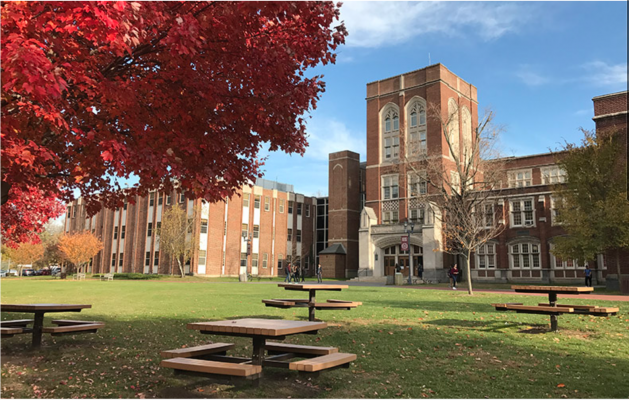 Recently, the Scarsdale High School administration announced that starting March 8th students will spend an extended amount of time learning in-person. Instead of going in only during Monday and Thursday mornings for four hours at a time, students in Cohort A will now remain in school for an additional three hours. Similarly, students in Cohort B will spend Tuesday and Friday afternoons in Scarsdale High School as well as the previously scheduled mornings.
Recently, the Scarsdale High School administration announced that starting March 8th students will spend an extended amount of time learning in-person. Instead of going in only during Monday and Thursday mornings for four hours at a time, students in Cohort A will now remain in school for an additional three hours. Similarly, students in Cohort B will spend Tuesday and Friday afternoons in Scarsdale High School as well as the previously scheduled mornings.
More in-person schools will follow suit as on Sunday March 7, the district announced that Scarsdale High School is slated to open to full, in-person learning on April 19th. Although details are not known about the April schedule, it has already produced much conversation among the Scarsdale High School student body. “At first, I had been dreading the April 19th schedule because I thought each day would seem a lot longer. However, after my first full day of school on March 8th I realized how energizing being around all of my friends was. Lunch is something I'm really glad I get to spend with them now. Classes... have mostly been the same experience. Even though they are shorter, they feel similar to fifty minute class periods, but being in the school has made them less draining and easier to get through,” remarked Emily Wang, a Scarsdale High School sophomore who is learning hybrid. “We do not know a lot yet about the new schedule, but from what I can tell it seems like school is finally beginning to return to normal. I am definitely excited because it indicates that we have finally gotten to the other side of the pandemic... I am also worried that going back to five full days will be a big adjustment to make,” added Charlotte Davis, a Scarsdale High School junior who has selected the hybrid model.
The administration plans to maintain the standard of six feet between student desks and a classroom capacity of approximately 50% of normal occupancy. All periods will be reduced to forty minutes except period 10, which is currently period 5, being 25 minutes. Students will be permitted to leave the campus during free periods assuming they properly follow safety protocols. Last, the new schedule will include designated school lunch periods during which students and teachers can dine either inside or outside the school. As far as inside dining, students will be confined to their lunch seats by polycarbonate barriers, will record their lunchroom and seat number on a Google form daily and maintain six feet of distance from one other — the last guideline applying to outdoor seating as well.
As to why this course of action is being taken, the administration explained, “We are making this change to increase the time students are in the school building, as we know that the in-person educational experience benefits learning and mental health. There is no evidence that the virus has been transmitted in classrooms with appropriate physical distancing and mask-wearing. Revised protocols were implemented in January which does not require students or teachers in such classrooms to quarantine.” Other factors contributing to the administration’s decision include the decrease of positive case percentages and cases per 100k in Westchester County as well as the increased availability of vaccines for educators and the wider community.
In addition to health metrics demonstrating extremely low in-school spread, the administration believes more in-person school time will enhance academic experiences and social/emotional health and mitigate the difficulties of remote and hybrid educational models.
What effect, if any, will the new schedule have on whether students choose to attend in-person school or remain virtual?
The new schedule has convinced many previous all-virtual students to once again enter the halls of Scarsdale High School while several remain unaffected by the news. “After the schedule change, I made my decision to go back in person based on a few reasons. The biggest reason was the fact that spending a full day in school is a step towards normalcy and returning to life pre-COVID which is very exciting. Another factor was I just could not fathom the idea of staring at my computer screen for the entire day,” reflected SHS junior Anna Forest. Conversely, “the new schedule does not impact my decision at all. I choose to stay away from school predominantly because of the health risks, but I've also become accustomed to the home-learning routine and I quite like it,” added SHS junior Lydia Jin who has chosen to remain all-virtual. “My decision to return to in-person school with the April schedule, however, depends on what happens in the next few weeks. My family and I would only feel safe risking exposure if the majority of students get vaccinated, and we're not quite there yet, so I anticipate staying virtual for the rest of the school year,” added Jin.
In February, Principal Bonamo alongside the Scarsdale High School government sent out a video urging students to attend in-person school, which could have played a role in the shifting dynamics of school attendance. Although no specific conclusion can be drawn, it is clear that the new schedule has persuaded a decent amount of previous all virtual students to return to the building. “From walking around today and talking to teachers...early feedback indicates more students are coming to school,” mentioned Bonamo, reflecting on the March 8th school day. It is also evident that students will continue to have the choice to either attend in-person or virtual school depending on their personal preference.
Another consideration is how the new schedule will affect the student population aside from which mode of learning they select. A major incentive to enacting the new schedule is the potential positive effect it could have on student mental health. “I think the change may be difficult at first because students are so used to the hybrid schedule and returning to full days may initially be tiring. With time, I think this will have extremely positive mental health effects because we will be able to interact with our peers all day instead of being isolated in our rooms,” mentioned Forest. With the new schedule, in-person students will spend more time in classrooms conversing with peers and teachers alike; as in-person interactions have been proven to alleviate feelings of social isolation, which are most prevalent in today’s society, the new schedule could easily improve student mental health.
For virtual students who have extenuating circumstances and are unable to attend in-person school, the new schedule poses several worries. At the start of the school year, the minority of the student body was learning solely from home, which meant teachers were focusing more of their attention and energy on those in the classroom rather than on the computer screen. However, as the year progressed, more and more students became attracted to the flexibility and ease of virtual-learning. Rather than attend school for only a small portion of the day, students wanted to enjoy the benefits of online learning including a familiar environment and more time to focus on one’s health. With the population of virtual students increasing, teachers were forced to adapt their mode of learning to equally engage in-person and virtual students.
As the new schedule incentivizes students to come to school, those who remain all-virtual are scared that their teachers will once again solely focus on those physically in the classroom. “At the start of the year when I was the only all-virtual student in most of my classes, several teachers were not very accommodating, and sometimes they would even forget to start the Zoom call. I hope that by now most teachers know how to make virtual learning efficient, but I still worry that they won't pay much attention to me anymore,” remarked Jin.
As it’s now a year since the COVID-19 pandemic shut down Scarsdale High School, a widespread notion is that students feel as though their lives have become rather monotonous and consumed with routine. Having a new schedule introduced just in time for spring may very well provide high school students with something to look forward to and a break an otherwise mundane routine. More in-person school could mean a taste of pre-COVID times and a glimmer of hope in a time when we need it the most.
What Metrics Need to Be Met to Reopen Scarsdale Schools?
- Details
- Written by Joanne Wallenstein
- Hits: 4040
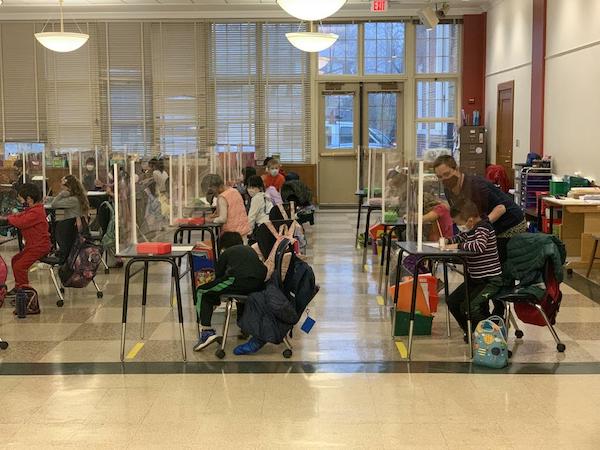 With so many neighboring districts reporting plans to re-open schools full time as well as the availability of vaccines for teachers and indications from the NYS Health Commissioner that the six foot social distancing requirement may be relaxed, many are wondering what’s holding Scarsdale back from re-opening the schools?
With so many neighboring districts reporting plans to re-open schools full time as well as the availability of vaccines for teachers and indications from the NYS Health Commissioner that the six foot social distancing requirement may be relaxed, many are wondering what’s holding Scarsdale back from re-opening the schools?
Ardsley, Bronxville, Briarcliff, Byram Hills, Chappaqua, Dobbs Ferry, Eastchester, Harrison, Hastings on Hudson, Mt. Vernon, New Rochelle and Rye are either in school full time or have announced plans to transition to full time school in the next few weeks. In Scarsdale, elementary school students will return to school, however the Middle School is only moving to 2 days and alternate Wednesdays on March 17 and the High School is going from 2 half days to 2 full days in school on March 8.
Plastic Barriers
We learned that the district has purchased plastic partitions and thought that might be a sign that a fuller return to school was in the offing, however the information we received from Superintendent Thomas Hagerman offers no timeline and makes no guarantees. Here are responses from Hagerman received on March 1, 2021:
(Q) The parents shared the news that the district has purchased 4,200 barriers to be used for grades 3-12. Will these be installed soon or are they intended for the fall?
(A) So far we have spent approximately $180K in total for barriers as follows:
-Mid/Late Summer 2020: $53,000 - 660 barriers primarily for special education settings and one for each classroom for one on one instruction if needed. Also for offices. Prices were extremely high at this point and time was of the essence.
-Late-Fall 2020: $32,000 – 1,200 barriers for k-2 students primarily used at lunch.
-Early-Feb (on order): $93,000 – 4,200 barrier for grades 3-12 primarily to be used at lunch and instructionally as determined by teachers.
-An additional $2,000 for miscellaneous other barriers needed along the way related to all of the above
(Q) Howard Zucker has indicated that the state is re-examining the six-foot rule and says he wants to get kids back in school. Will this change the district’s plans?
(A) If the NYSDOH changes the social distancing requirement to say, 3ft., this will not change plans--which has always been to get all kids back in school as soon as it is safe to do so for students and teachers--but it would certainly accelerate our timeline.
(Q) I am sure you are aware that many Westchester districts have now announced plans to fully re-open in March and April. Do you expect Scarsdale to follow suit?
Like other districts, we have been planning for a full return throughout this process. The availability of vaccinations for faculty and staff is new risk mitigation that we will believe will help us lessen six-foot social distancing and get us back into school more quickly.
Metrics
Since the beginning of the crisis, parents requested a list of required metrics that, if reached, would enable full-time school to open. Concise criteria for opening were never presented, but one fact was clear. Both the administration and the Board of Education insisted that the school’s physical plant could not accommodate the full school population at six feet apart as required by the NYS Department of Health.
Social Distancing
When parents repeatedly questioned calculations that showed there was insufficient space inside the buildings, the administration invited district architect’s BBS to present their plans at an 11/16/20 Board of Education meeting. At the time, Architect Kevin Walsh of BBS shared his schematics for the layout of two sample elementary school classrooms, one at Heathcote and another at Edgewood. Walsh showed desks placed six feet apart with 56 square feet of space per occupant. According to Walsh, the layout must allow for two means of egress from each classroom. For a classroom of 785 square feet, 14 students could be accommodated along with a teacher and an aid. Depending on the number of teachers and aids, an additional student or two could be added.
Relying on these calculations the board and the administration spent months claiming that this was a major hurdle for full time school.
Frustrated with the architect’s analysis, Scarsdale resident Irin Israel obtained floor plans of the elementary schools and used a graphic approach to draw in the desks in the rooms. He quickly noted that desks that bordered the walls of the rooms did not need six feet of distance on the side abutting the wall, saving considerable space.
However, when he presented his renderings to the district, they failed to acknowledge his solutions. He wrote to the Board and administrations saying, “Comparing the architect’s square footage method (which was used to make all layout determinations and decisions this past summer and fall) to the graphic method (which I presented on 11/9/20), the graphic method allowed for an additional 507 kids to fit in our Scarsdale schools at six-foot distancing (17% more children).
Then suddenly, on February 9, 2021 Superintendent Thomas Hagerman announced that students in grades three through five would return to school in March, following grades K-2 on November 30, 2020. This meant that the elementary schools would be fully populated with students and staff.
Explaining the change in direction, Dr. Hagerman made a distinction between six feet of social distancing and remaining “functionally six feet apart.” Here is what his email said.
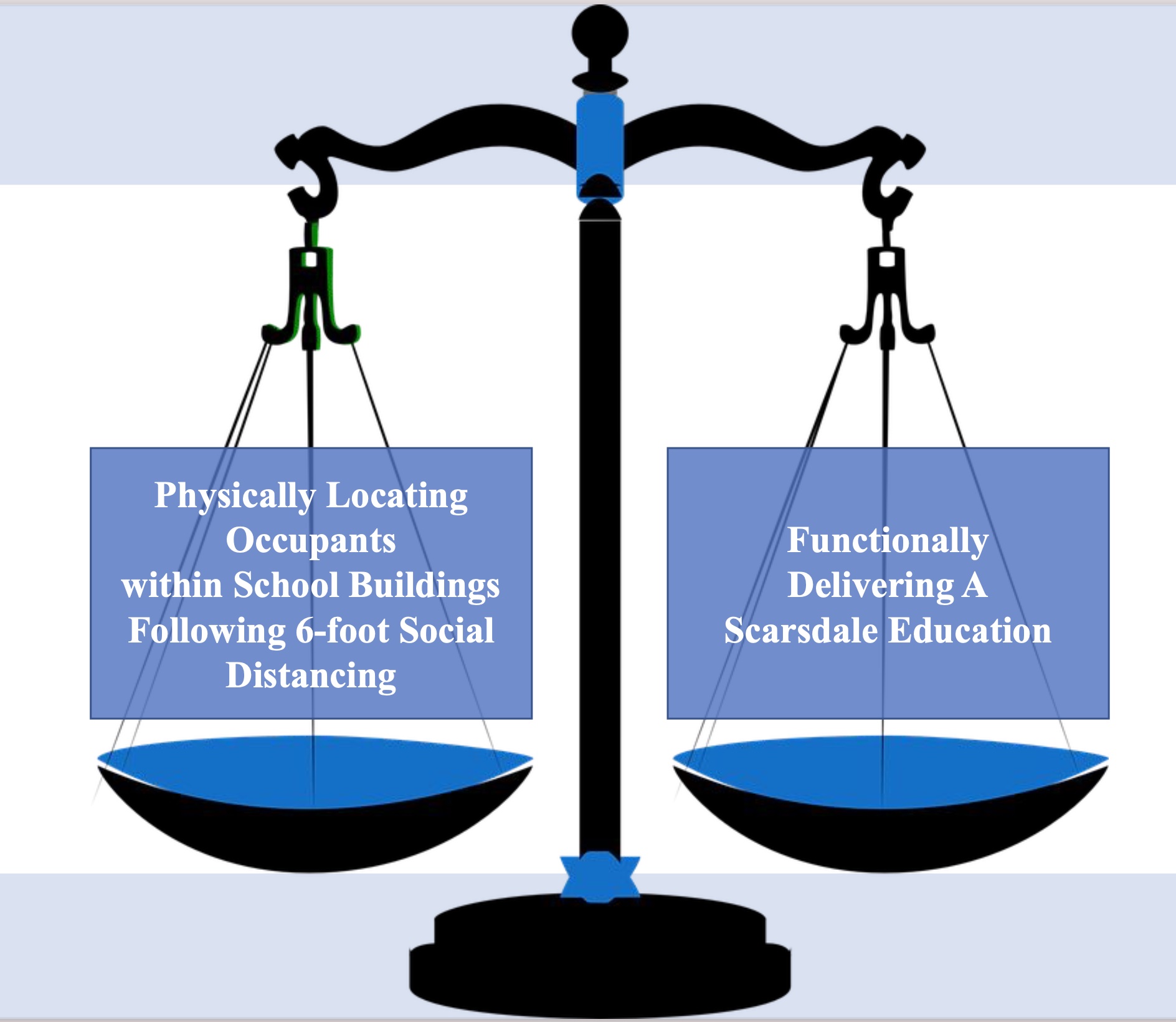 A report from District Architects BBS dated January 8, 2021 showed that the full school populations of each elementary school could safely attend school.
A report from District Architects BBS dated January 8, 2021 showed that the full school populations of each elementary school could safely attend school.
“Specifically, how can students fit back into our buildings when we were told they could not because of the need for six-foot social-distancing? The answer is that students could not have fit all this time and remained functionally six feet apart. The idea of social-distancing focuses on reducing the contact between all individuals in an environment. In our assessment, this concept goes beyond the measurement of six feet between desks to encompass the full range of functions necessary to run a school. The new arrangement moves from a more cautious application to accepting a purely mathematical interpretation of 6 feet of distance. This represents a fundamental change in our application of social-distancing, and, at least partially, weakens one of our core mitigation efforts. We resisted this for some time primarily because of health and safety promises we had made to the staff and community, but also because we did not have confidence in our ability to run “school” safely and effectively, given the complex intricacies of a typical day.”
Now a response to a FOIL request from Israel, reveals that the district was aware that there was adequate space in the schools for all elementary school students to be social distanced at six feet. In fact, the administration received a report from district architects BBS dated January 8, 2021, that demonstrated how the rooms could be laid out to give students and teachers ample space. Why the change in the numbers?
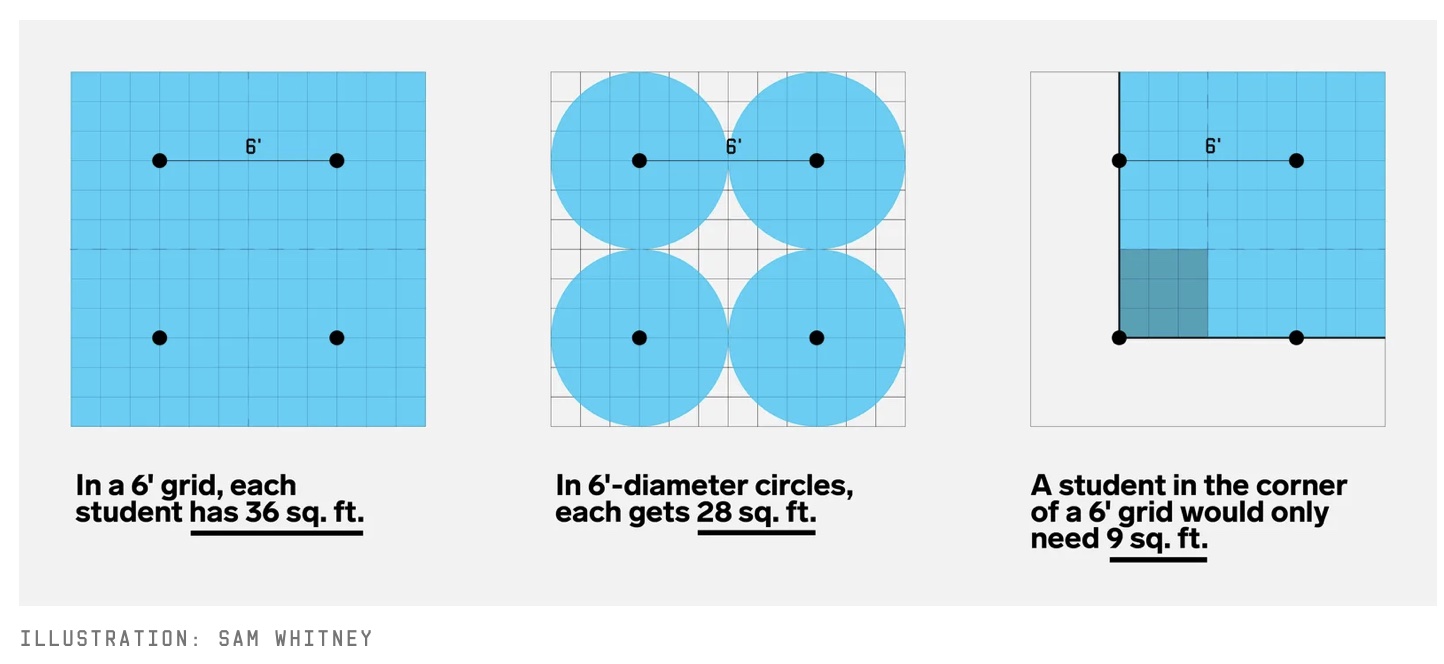 An analysis from Wired Magazine shows that 56 square feet of space per student is far more than is needed to maintain 6 feet of social distancing.It appears that the architects initially used a simple mathematical calculation to determine how many students could safely fit into schools. Architects assumed that each student would need 56 square feet of space, and they took that number, divided it by the total square footage of the school and calculated the number of people that could be safely placed in the building. That figure of 56 square feet was far higher than the 44 square feet used by neighboring districts –and 44 square feet was later determined to also be too high. See the analysis here:
An analysis from Wired Magazine shows that 56 square feet of space per student is far more than is needed to maintain 6 feet of social distancing.It appears that the architects initially used a simple mathematical calculation to determine how many students could safely fit into schools. Architects assumed that each student would need 56 square feet of space, and they took that number, divided it by the total square footage of the school and calculated the number of people that could be safely placed in the building. That figure of 56 square feet was far higher than the 44 square feet used by neighboring districts –and 44 square feet was later determined to also be too high. See the analysis here:
In the report from the architects dated January 8, they compare the square footage method to the graphic method and determine that all students and teachers could safely attend school, and there would still be remaining open spaces. In the most extreme example, only 22 rooms at Greenacres would be needed, leaving 18 rooms including the learning commons, gym and new multipurpose rooms open for use.
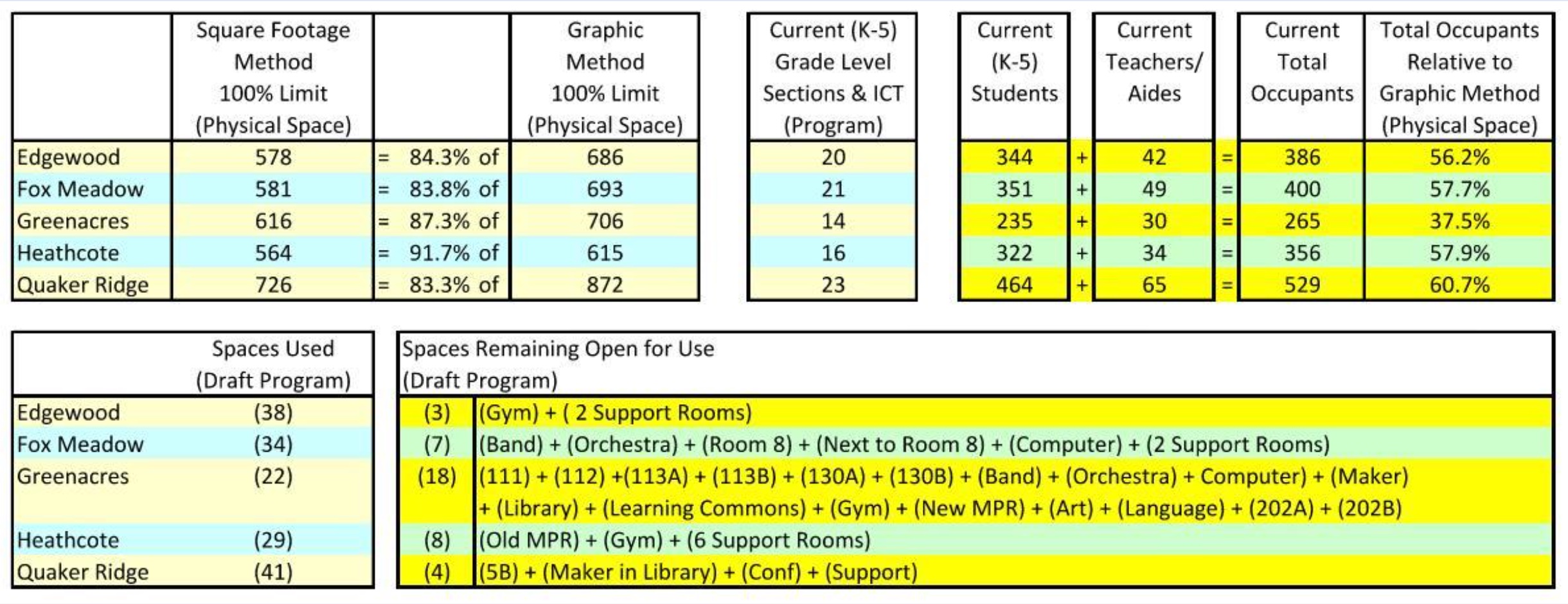 January 8, 2021 analysis from BBS Architects
January 8, 2021 analysis from BBS Architects
However, as far as we know, the administration did not share this report with the Board of Education and did not make it available to the public.
With this new information in hand, Israel shared it with Board of Education and asked the following:
1) Comparing the architect’s square footage method (which was used to make all layout determinations and decisions this past summer and fall) to the graphic method (which I presented on 11/9/20), the graphic method allowed for an additional 507 kids to fit in our Scarsdale schools at six-foot distancing (17% more children).
2) 40 rooms, including some large rooms like gyms, would be unused and not needed for classes (but could be used for other purposes) even with all children fitting at six-foot distancing. 40 empty rooms.
3) Zero rooms need more than capacity (at six feet), only 12 rooms total in the 5 schools would be 100% capacity (at six feet), and 79% of rooms used would be at 80% or less of capacity (at six feet).
Basically, it’s not even close.
Before you yell “density!”, keep in mind that we have yet to hear any metrics of density and where the line between safe and unsafe lies. 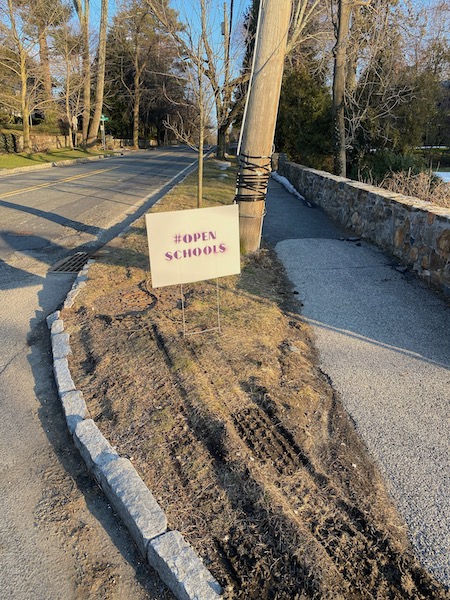 Sign on Fenimore RoadRegardless, with these drawings, while the school density would obviously increase, the density per classroom would not increase at all.
Sign on Fenimore RoadRegardless, with these drawings, while the school density would obviously increase, the density per classroom would not increase at all.
I spent much time this past fall illustrating exactly what these documents show, and here, it is unequivocally proven true: that all current in-person Scarsdale elementary children can fit full-time at six feet and have been able to fit since the beginning of the school year.
1) Is BBS Architects the correct district architect for Scarsdale? This architect has blatantly dropped the ball by using a sub-par mathematical equation to position the children in our schools. This was a simpler and less effective method, rather than doing the full work to assess the maximum capacities within the safety regulations. Their information misled the district and community and affected many critical decisions this year.
2) After denying the truth of this information, the District learned the truth on 1/8/21, yet did not share this pertinent information with the community nor the Board. In fact, I would suggest that the administration would not have revealed this information to the Board had it not been for my request, since they had not revealed it until my request was being filled 7 weeks later. This is further lack of transparency. This is information that must be used to judge the Administration’s performance in attempting to follow the Board’s policy directive of getting the children back into school full-time safely and according to the regulations this year. It is critical that this information be used when judging the performance of the current Superintendent and Administration this school year.
What’s Next?
The district’s lack of transparency, even with the Board of Education, is puzzling. Why did they conceal this information? What other factors are preventing the opening of the schools? What is the district’s agreement with the teachers’ union? With adequate social distancing, a supply of plastic barriers and staff vaccinations in place, what are the reasons for not reopening schools?
As the weeks go by, and many grow increasingly frustrated with ZOOM school, social isolation and fears for their children, many parents are waiting for answers.
District Presents First Pass at Proposed 2021-22 School Budget
- Details
- Written by Sammy Silberberg
- Hits: 1661
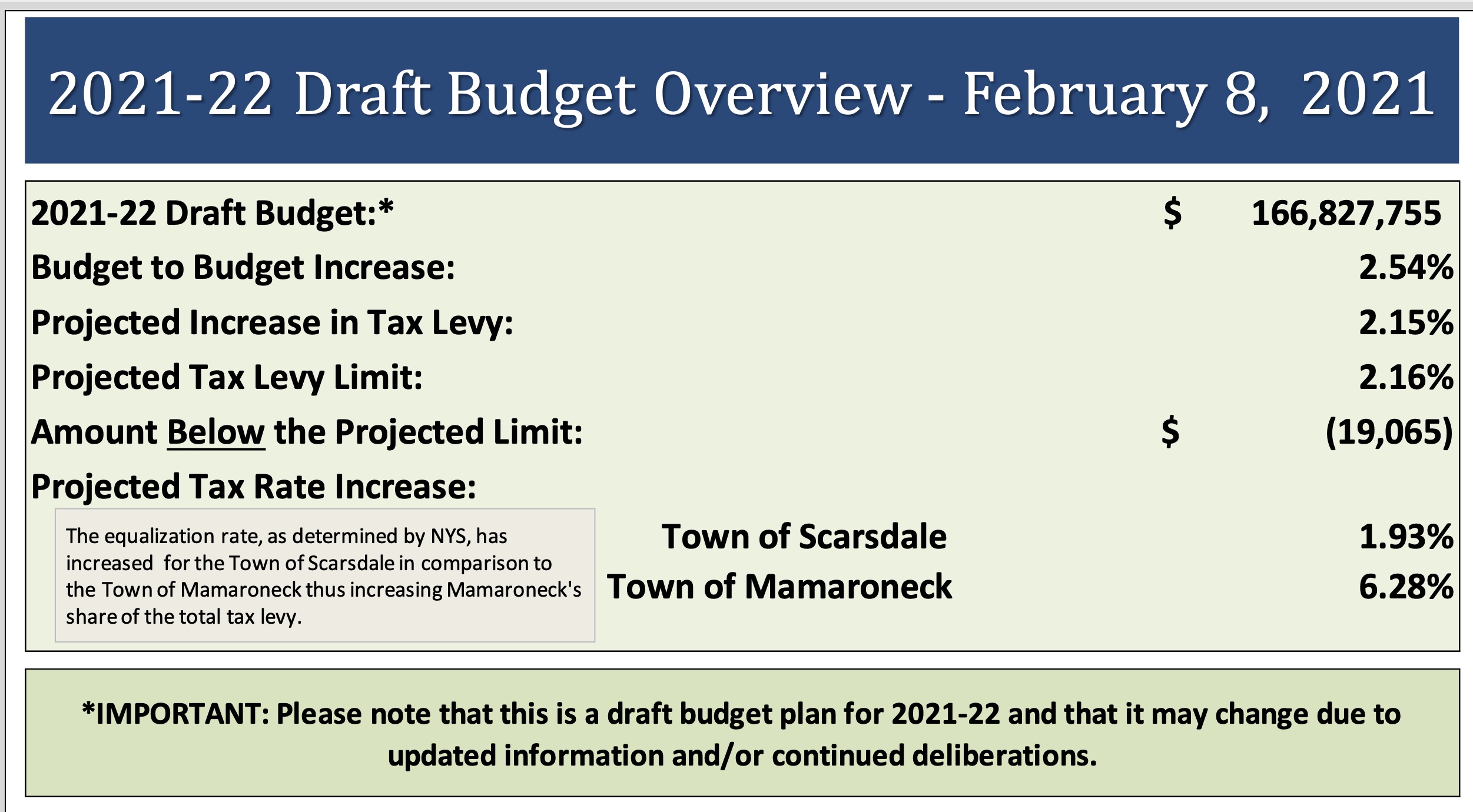 Hopeful that the 2021-22 school year will return to normal, the Scarsdale Schools held their first budget study session for the proposed 2021-22 school budget on Monday, February 8, 2021 via Zoom. Though the budget assumes kids will be back in school, the district is also including contingency funds for two remote teachers and technology and PPE in case COVID continues to affect the educational program.
Hopeful that the 2021-22 school year will return to normal, the Scarsdale Schools held their first budget study session for the proposed 2021-22 school budget on Monday, February 8, 2021 via Zoom. Though the budget assumes kids will be back in school, the district is also including contingency funds for two remote teachers and technology and PPE in case COVID continues to affect the educational program.
During the meeting, Assistant Superintendent Stuart Mattey reviewed the 2021-2022 draft budget, budget drivers, debt service costs, transportation expenses, employee benefit costs, and athletic expenditures.
This preliminary budget calls for a 2.54% budget increase over 2020-21, for a budget of $166,827,755. This would mean a 2.15% increase in the tax levy, translating to a 1.93% increase for Scarsdale residents and a 6.28% increase for those in the Mamaroneck strip.
Mattey listed outlined what this budget will fund:
• Maintaining high-quality teaching and learning consistent with the Strategic Plan
• Advancing in-district instructional opportunities for students with disabilities
• Continuing a comprehensive approach to Safety, Security and Emergency Management
• Elevating district cleaning protocols in all elementary schools
• Improving and upgrading facilities
The proposal includes additional staffing including:
1 full time special education co-teacher for elementary school
1 full-time special education teacher for the Learning Resource Center at the high school
1 .4 speech teacher for the high school
1 .2 secretarial position for the middle school Psychologist
5 full time cleaners, one for each of the elementary schools.
Though no one knows at this point if remote learning will still be necessary, this draft budget includes $800,000 in funds from the fund balance to pay for 2 full time remote teachers, $330,000 for unanticipated non-recurring costs associated with COVID 19 such as expenses for technology, PPE or other equipment along with $250,000 to fund a summer enrichment program for elementary school students.
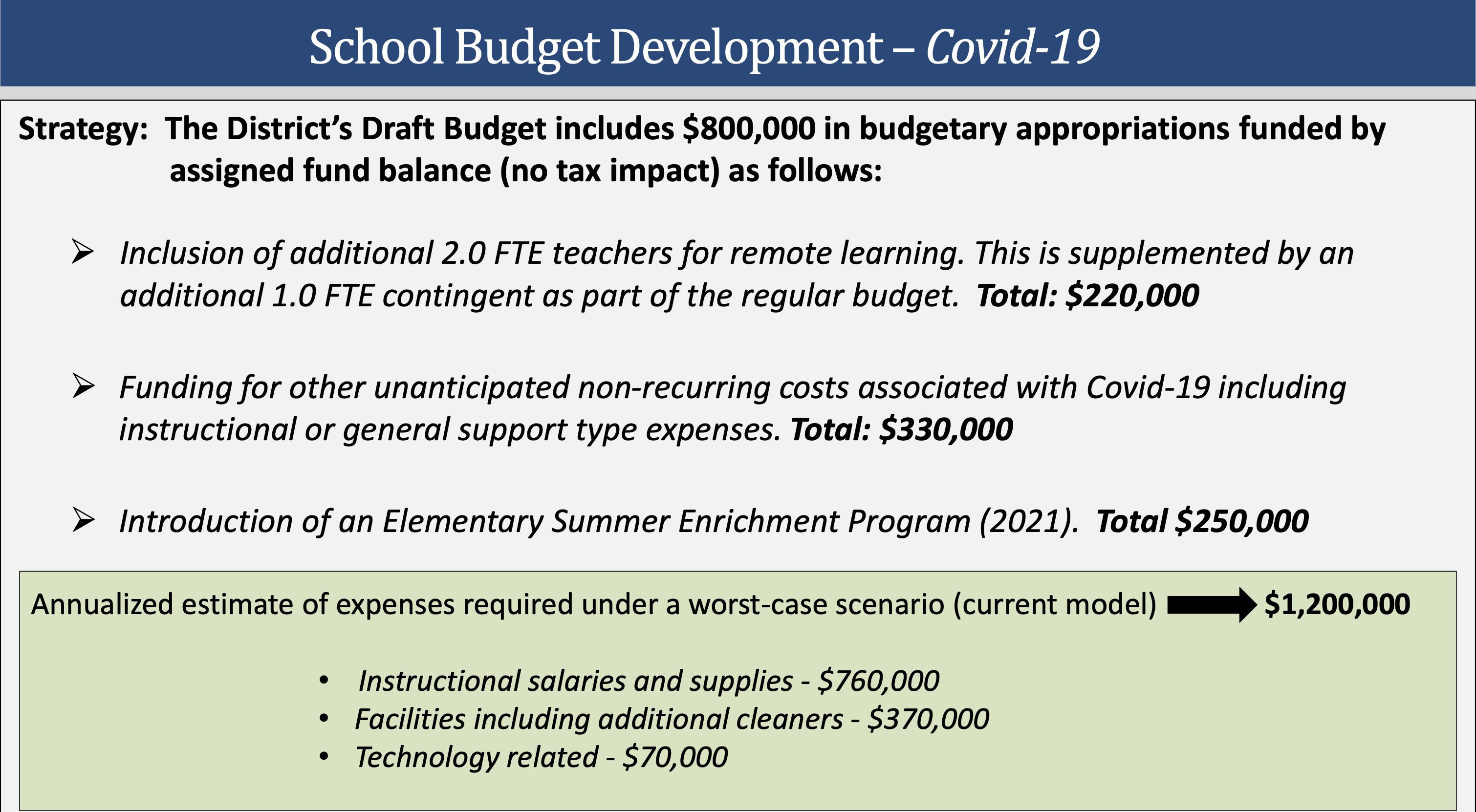 Though the district plans to be back in school in September, in case some hybrid or remote instruction is required, the district has put some contingency funds in the proposed 2021-22 school budget.
Though the district plans to be back in school in September, in case some hybrid or remote instruction is required, the district has put some contingency funds in the proposed 2021-22 school budget.
Summer Enrichment Program: Administrators are currently trying to gauge community interest in the enrichment program as they consider what the next steps should be. The goal of the program will be to enrich students’ literacy and mathematics development, and it will be open to all students who completed kindergarten through fifth grade. It will be staffed by Scarsdale teachers. Students who do not attend will not miss essential content, as the program will feature project-based learning activities that will engage students with skills and concepts they have already learned. They discussed the possibility of coordinating the program with the summer camp offered by the Village so that students could attend both the enrichment program and the Rec Day Camp.
Because the development of the program is based on community interest, Board member Ron Schulhof asked what the minimum number of students would be necessary for the program to run. Dr. Edgar McIntosh, the Assistant Superintendent for Instruction, stated that although exact figures have yet to be determined, the administration estimates that around 15% of students will be interested in the Enrichment Program and that this figure will make the project feasible.
Next, the Board reviewed the primary budget drivers for the proposed 2021-2022 budget.
The total impact of these changes is $3.816 million and includes:
• Contractual salary increases for all employees - $2.1677 million
• The District’s self-funded medical insurance budget increase due to plan experience and employee contributions - $922,000
• Covid-19 contingency funded from prior year surplus - $800,000
• Transfer to school lunch fund to cover losses - $175,000
• Contractual increases and improvements to security - $169,000
• Plan operation and maintenance for HVAC and electrical maintenance and snow removal equipment - $161,000
• Debt service - $151,000
• Transfer to Capital Fund ($379,000)
• Tax Certiorari decrease ($350,000)
Board member Amber Yusef later asked for details about increased security costs and Mattey said the District plans to update its process for an automated lockdown by integrating all of its systems with the process for alerting the police and the fire departments of the situation.
Fund Balance: As of June 30, 2020, the district fund balance was $26,664,738 which is projected to decrease to $23,035,349 by June 30, 2021. The unassigned fund balance will drop to $4,666,306 which is 2.8% of the draft budget. Customarily, the district retains 4% in the unassigned fund balance for unanticipated expenses.
Next, the Board reviewed several individual pieces of the budget, including transportation, debt service and lease purchases, employee benefits, and interscholastic athletics.
Transportation expenses account for approximately 3% of the Draft Budget. In the 2020-2021 budget, the actual cost was $4.173 million, and this year’s budget projects the cost at $4.544 million. This accounts for the continuation of all current policies, 63 bus drivers, and the planned purchase of 1 large bus, 2 mini-busses, and 1 van. This figure also accounts for contractual salary increases.
Debt Service and Lease Purchasing accounts for 6% of the budget. In 2020-2021, the actual cost for this expense was $7.281 million, and the proposed cost in this budget is a 2% increase, resulting in a $7.491 million expense. This includes a continuation of the District’s technology lease purchasing plans, computer lease payments, and copier replacement plans.
Employee Benefits comprises 22% of the proposed budget. This expense was $36.805 million in the 2020-2021 fiscal year, and it is projected to increase to $37.241 million for the 2021-2022 year. This includes employee insurance costs, New York State retirement system costs, and other insurance expenses.
On a percentage basis, one of the largest increases in the proposed budget is for athletics, which totaled $1.858 million for 2020-21, and is projected to go up to $2.171 million for 2021-22. This represents a budget-to-budget increase of 9.42% to fund supplies, uniforms, sports entry fees, certification expenses, equipment, and equipment reconditioning.
The primary reason for the increase is to fund athletic training supervision and coaching. Director of Physical Education, Health & Athletics, Ray Pappalardi explained that it has become a standard best-practice to have an athletic trainer on standby to help with any potential injuries during events. The district currently has one full-time athletic trainer, and there were gaps in coverage during sports practices and competitions. For example, Mr. Pappalardi stated that oftentimes during football season, one athletic trainer must be with the team at an away game and it would benefit the District to have an additional trainer on staff to circle around to home team fields. In addition to football, other higher-risk teams would benefit from an offsite trainer during events and competitions.
Following the presentation, the Board posed questions about the STAR Rebate Program which may be changed by the state along with the decrease in the unassigned fund balance which could pose risks down the line. They asked for the cost for additional furniture and equipment to bring third through fifth graders back to school were in the budget and learned that this expense has not been planned for as yet. These funds will have to come out of the fund balance, which will decrease. However, these expenses may be offset by state aid which may come in but is not counted in this proposed budget.
The next budget meeting will be held on March 1 and will include a Draft Budget plan update and department budget presentations. The third budget meeting will be held on March 8 and the Budget Forum and Review will take place on March 22. Finally, the Board of Education will adopt the budget on April 12 and the final vote will take place on May 18.
SHS Students Invited to Apply for Students Inside Albany Program
- Details
- Written by Joanne Wallenstein
- Hits: 1401
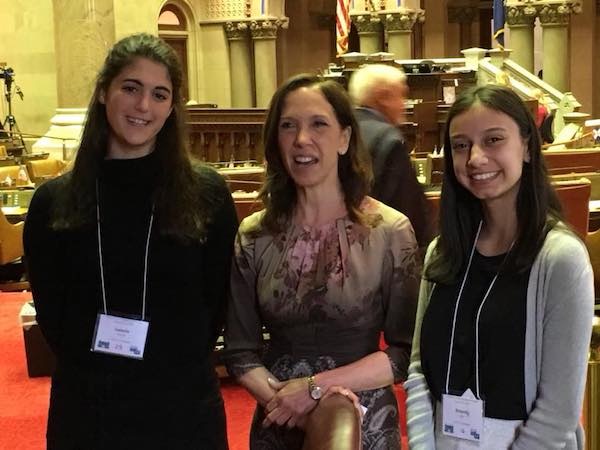 For the 10th consecutive year, the League of Women Voters of Scarsdale will select two high school students to attend the annual Students Inside Albany Conference to take place on Friday, May 21st from 4:00-6:00PM and Saturday, May 22nd from 10:00AM-4:30PM. Any Sophomore, Junior or Senior student who attends Scarsdale High School or who resides in the school district is eligible to apply.
For the 10th consecutive year, the League of Women Voters of Scarsdale will select two high school students to attend the annual Students Inside Albany Conference to take place on Friday, May 21st from 4:00-6:00PM and Saturday, May 22nd from 10:00AM-4:30PM. Any Sophomore, Junior or Senior student who attends Scarsdale High School or who resides in the school district is eligible to apply.
This year, Students Inside Albany will be a virtual event designed to immerse students in the process by which public policy is proposed, revised and enacted in New York State. Similar to past years, the agenda will be packed with tools to instruct students on how to influence public policy decision-making at the state level. Similarly, the highlight of the in-person program of meeting with legislators will continue, as the League will arrange virtual meetings in small groups with state legislators to discuss issues and advocacy.
Scarsdale students who attended this program in the past were unanimous in their enthusiasm about the program.
The Students Inside Albany Conference will continue to be free for students to attend.
Applications and more information are available on the LWVS’s website under the Youth Programs tab (https://lwvs.org/students-inside-albany-2021/) and are due by March 3, 2021.
Please contact LWVSyouthprograms@gmail.com for more information.
Nominating Committee Seeks Candidates for Scarsdale Board of Education
- Details
- Written by Joanne Wallenstein
- Hits: 1963
 The School Board Nominating Committee (SBNC) is seeking to identify potential candidates to serve on the Scarsdale Board of Education. The SBNC held its first meeting of the 2021 season on January 24th and is now engaged in active outreach to build a robust candidate pool.
The School Board Nominating Committee (SBNC) is seeking to identify potential candidates to serve on the Scarsdale Board of Education. The SBNC held its first meeting of the 2021 season on January 24th and is now engaged in active outreach to build a robust candidate pool.
Over the next several weeks, SBNC members will recruit and review candidates in order to nominate two candidates for the nonpartisan slate in the next school board election. The school board election and budget vote are slated for Tuesday, May 18, 2021. Of the two school board members who will complete three-year terms this year, only one of them is eligible for renomination. Board President Pam Fuehrer will complete two terms this year and Board Vice President will complete one term and is eligible for nomination.
The SBNC invites all Scarsdale School District residents to propose names of qualified individuals to serve on the Scarsdale Board of Education by email to sbncchair@gmail.com. A candidate must be at least 18 years old, a U.S. citizen, a qualified voter, and a resident of the Scarsdale School District for at least one year prior to the May 18th school board election date. Nikki Hahn, SBNC Chair, stated: “The non-partisan SBNC process is critical to the excellence of our Board of Education and our schools. This year we will be proposing two candidates for the Board, and we hope service-minded residents will embrace this opportunity to help shape the educational policies that profoundly affect the children of our community.”
Interested candidates should complete a biographical information form and submit it via email to the SBNC Chair, Nikki Hahn, at sbncchair@gmail.com as soon as possible, but no later than 11:59pm on Tuesday, February 23, 2021. Application form is available on the SBNC website at www.scarsdalesbnc.com. Please see the “Join the School Board” tab or contact the SBNC Chair for further information.
Contacts:
Nikki Hahn, Chair
Kerry Hayes, Vice Chair














